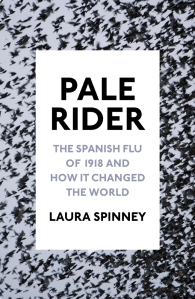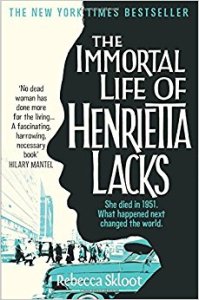 Pale Rider: The Spanish Flu of 1918 and How It Changed The World by Laura Spinney probably isn’t what most people consider to be cosy festive reading over Christmas but it is somewhat seasonal. Much of what has been written about the Spanish flu tends to focus on the impact it had on Western countries in the aftermath of the First World War but Spinney’s book is a refreshingly global account of how the virus reached all corners of the earth from Alaska to Rio de Janeiro to Samoa to China. Estimates remain vague but the Spanish flu is believed to have killed at least 50 million people worldwide, possibly as many as 100 million, and its rapid spread is likely to have been partly exacerbated by soldiers returning home at the end of the First World War.
Pale Rider: The Spanish Flu of 1918 and How It Changed The World by Laura Spinney probably isn’t what most people consider to be cosy festive reading over Christmas but it is somewhat seasonal. Much of what has been written about the Spanish flu tends to focus on the impact it had on Western countries in the aftermath of the First World War but Spinney’s book is a refreshingly global account of how the virus reached all corners of the earth from Alaska to Rio de Janeiro to Samoa to China. Estimates remain vague but the Spanish flu is believed to have killed at least 50 million people worldwide, possibly as many as 100 million, and its rapid spread is likely to have been partly exacerbated by soldiers returning home at the end of the First World War.
Scientists at the time of the outbreak were gaining a better understanding of germ theory but knew very little about viruses. There is still a fair amount of speculation about the true extent of the Spanish flu, with three separate theories about where it originated from (despite its name, Spain is not one of them). Spinney argues that this lack of knowledge goes some way towards explaining why the flu hasn’t been imprinted in the collective memory despite its vast scale. However, the pandemic has shaped the course of history in striking ways. In one example, Spinney notes that a German immigrant to America who died from Spanish flu had taken out a life insurance policy for his widow and son who invested his legacy in property. The son prospered financially and later had a son of his own whose name is Donald Trump.
2018 marks a century since the first wave of Spanish flu spread across the world and I hope Spinney’s accessible and comprehensive account of the historical, cultural and scientific implications of one of the deadliest pandemics will gain more attention this year.
 On a similar subject, The Health of Nations: The Campaign to End Polio and Eradicate Epidemic Diseases by Karen Bartlett look at the history of vaccination and disease eradication programmes with a focus on polio. While smallpox was officially declared eradicated nearly four decades ago, polio remains endemic in Nigeria, Pakistan and Afghanistan and Bartlett examines why this is still the case, despite the development of the Salk and Sabin polio vaccines to contributions made by billionaire philanthropists such as Bill Gates towards eradication programmes.
On a similar subject, The Health of Nations: The Campaign to End Polio and Eradicate Epidemic Diseases by Karen Bartlett look at the history of vaccination and disease eradication programmes with a focus on polio. While smallpox was officially declared eradicated nearly four decades ago, polio remains endemic in Nigeria, Pakistan and Afghanistan and Bartlett examines why this is still the case, despite the development of the Salk and Sabin polio vaccines to contributions made by billionaire philanthropists such as Bill Gates towards eradication programmes.
As well as the challenges of funding and developing viable vaccines, the logistics of innoculating people in poor and remote parts of the world are particularly difficult with the remaining unvaccinated populations proving the hardest to reach. Healthcare workers have to engage communities, combat stigma and navigate various security and terrorist threats in order to carry out their work as well as dealing with a frustrating number of bureaucratic obstacles including budgetary constraints and competing priorities. The politics surrounding vaccination also remains controversial and there is a very interesting chapter about the anti-vaccine movement in which Bartlett clearly lays out the pros and cons of each side of the argument.
Some of the detail about global healthcare infrastructure may have less appeal for the general reader compared to ‘Pale Rider’ but overall, ‘The Health of Nations’ provides a great deal of insight into the complex issues surrounding vaccination and disease eradication.
 ‘Pale Rider’ and ‘The Health of Nations’ are potential nominees for this year’s Wellcome Book Prize longlist due to be announced next month. The Immortal Life of Henrietta Lacks by Rebecca Skloot won the WBP back in 2010 and is a narrative non-fiction account about a poor black woman originally from Virginia named Henrietta Lacks who died in 1951 and how her cancer cells (later known as HeLa) were used for several groundbreaking medical research programmes from the development of IVF to gene mapping. However, while Henrietta’s cells have contributed towards some of the most important scientific discoveries in recent decades, they were taken without her consent and her family never received financial compensation despite pharmaceutical companies making billions in profit from them.
‘Pale Rider’ and ‘The Health of Nations’ are potential nominees for this year’s Wellcome Book Prize longlist due to be announced next month. The Immortal Life of Henrietta Lacks by Rebecca Skloot won the WBP back in 2010 and is a narrative non-fiction account about a poor black woman originally from Virginia named Henrietta Lacks who died in 1951 and how her cancer cells (later known as HeLa) were used for several groundbreaking medical research programmes from the development of IVF to gene mapping. However, while Henrietta’s cells have contributed towards some of the most important scientific discoveries in recent decades, they were taken without her consent and her family never received financial compensation despite pharmaceutical companies making billions in profit from them.
There are three main strands to this book. Firstly, Skloot outlines the background of the HeLa cells themselves and the scientific experiments they were used for. Secondly, she shines a light on medical ethics in the pharmaceutical industry, the treatment of black patients in medical institutions and the legal ramifications of consent. And finally, Skloot paints a portrait of Henrietta and her family, interweaving her life story with that of her “immortal” cells. The Lacks family initially wanted nothing to do with Skloot, who proved to be remarkably persistent in pursuing information about Henrietta, and equally thorough in uncovering the full extent of how her cells have been used in medical research.
Much like The Hare with Amber Eyes by Edmund de Waal and other part-biographical multi-genre non-fiction books, it is the personal angle of Henrietta’s story combined with Skloot’s assured investigative reporting style which makes ‘The Immortal Life of Henrietta Lacks’ such an engaging book with wide appeal. I would recommend it to any general non-fiction reader.





The Immortal Life of Henrietta Lacks is probably one of my favourite books that I’ve read in the last 10 years. It’ll be interesting to see if your other two make it onto the Wellcome longlist. (I love that Drumpf aside!) I will probably wait until shortlist time to start hoovering up any books I haven’t already read. Are you interested in being on a shadow panel if I do it again this year?
LikeLike
Yes, I’ve been meaning to get round to some past WBP winners for ages and I’m glad I’ve read the Skloot book now. Assuming they’ve been submitted I’d be happy to see Spinney or Bartlett on the longlist. WBP shadow panel is definitely a possibility – it would be good to do something different this year after 3 years of shadowing MBIP.
LikeLike
Hooray! It’s unofficial, but fun. And maybe they’ll invite us onto a blog tour again.
The Henrietta Lacks movie is pretty good, too.
LikeLiked by 1 person
I loved the Immortal Life of Henrietta Lacks and am so glad that her story was given such acknowledgement through the publication of this book.
LikeLike
Yes, definitely an important story given how much the cells have contributed towards medical research. It’s very well told too.
LikeLike
Will probably read Pale Rider and the Henrietta Lack book. The best book that I have read, so far, on the Spanish Flu is The Great Influenza by John M Barry. It explained that one reason for its nomenclature is that news of the growing catastrophe was deliberate suppressed in the national papers everywhere except Spain…his book traced the genesis to farmers in America. Very intriguing.
LikeLike
Yes, Spinney suggests that it was wrongly believed to have originated from Spain. It’s also known as the German flu in Brazil and the Brazilian flu in Senegal! The farmers in the US is one of the main theories while China or France are the other possible sources.
LikeLike
I have an amateur fascination with epidemiology, so the Spinney and Barlett look great. My book club keeps circling around The Immortal Life of Henrietta Lacks but has yet to select it.
LikeLike
Yes, it sounds like they would definitely appeal to you. I think the Henrietta Lacks book would be a good choice for a book club – lots of interesting issues to discuss.
LikeLike
I love the Immortal Life of Henrietta Lacks. I heard so many things about the cells during lecture, but never the woman behind it. Initially, I was afraid I wouldn’t like it but it captures me from page one. I didn’t expect to feel very strongly at the end of the book, but I did and I even wrote a long review-rant-ish on the topic of ethics.
LikeLike
Yes it’s well written and I thought the ethics arguments were explained very clearly.
LikeLike
Pingback: The Vaccine Race by Meredith Wadman | A Little Blog of Books
Pingback: The Wellcome Book Prize 2019 Shortlist | A Little Blog of Books
Pingback: Books In The Time Of Coronavirus | A Little Blog of Books